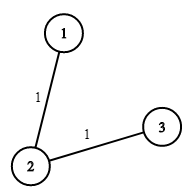LeetCode 1168. Optimize Water Distribution in a Village
题目描述:
There are n houses in a village. We want to supply water for all the houses by building wells and laying pipes.
For each house i, we can either build a well inside it directly with cost wells[i], or pipe in water from another well to it. The costs to lay pipes between houses are given by the array pipes, where each pipes[i] = [house1, house2, cost] represents the cost to connect house1 and house2 together using a pipe. Connections are bidirectional.
Find the minimum total cost to supply water to all houses.
Example 1:

Input: n = 3, wells = [1,2,2], pipes = [[1,2,1],[2,3,1]] Output: 3 Explanation: The image shows the costs of connecting houses using pipes. The best strategy is to build a well in the first house with cost 1 and connect the other houses to it with cost 2 so the total cost is 3.
Constraints:
1 <= n <= 10000wells.length == n0 <= wells[i] <= 10^51 <= pipes.length <= 100001 <= pipes[i][0], pipes[i][1] <= n0 <= pipes[i][2] <= 10^5pipes[i][0] != pipes[i][1]
题解:
1、wells数组可以看成是从村庄0到index处之间连接的代价
2、村庄(编号为1~n)有水只需要该村庄有通到村庄0的通路即可-即只需要把所有村庄连通即可,即形成一棵最小生成树,可采用Kruskal算法:即:
按照边的权重顺序(从小到大)将边加入生成树中,但是若加入该边会与生成树形成环则不加入该边。直到树中含有{\displaystyle V-1}
Kruskal算法的时间复杂度为{\displaystyle E\log E}
3、判断两个村庄是否相连可采用并查集。Lee215的实现如下:
int[] uf; public int minCostToSupplyWater(int n, int[] wells, int[][] pipes) { uf = new int[n + 1]; List<int[]> edges = new ArrayList<>(); for (int i = 0; i < n; i++) { uf[i + 1] = i + 1; edges.add(new int[] {0, i + 1, wells[i]}); } for (int[] p : pipes) { edges.add(p); } Collections.sort(edges, (a, b) -> Integer.compare(a[2], b[2])); int res = 0; for (int[] e : edges) { int x = find(e[0]), y = find(e[1]); if (x != y) { res += e[2]; uf[x] = y; --n; } } return res; } private int find(int x) { if (x != uf[x]) uf[x] = find(uf[x]); return uf[x]; }
这种实现十分简洁。
我的实现套用了自己常用的一套模版的类WQUPC(weighted quick union with path comparess),显得有些冗余,不过能够提升性能。
class Solution { class WQUPC { int[] id; int[] sz; WQUPC(int n) { id = new int[n]; sz = new int[n]; for(int i = 0; i < n; i++) { id[i] = i; sz[i] = 1; } } int root(int i) { while(id[i] != i) { id[i] = id[id[i]]; i = id[i]; } return id[i]; } boolean connected(int i, int j) { return root(i) == root(j); } boolean union(int i, int j) { int pi = root(i); int pj = root(j); if(pi == pj) return false; if(sz[pi] > sz[pj]) { id[pj] = id[pi]; sz[pi] += sz[pj]; } else { id[pi] = id[pj]; sz[pj] += sz[pi]; } return true; } } public int minCostToSupplyWater(int n, int[] wells, int[][] pipes) { List<int[]> edges = new ArrayList<>(); for(int i = 0; i < wells.length; i++) { edges.add(new int[]{0, i + 1, wells[i]}); } for(int[] pipe : pipes) { edges.add(new int[]{pipe[0], pipe[1], pipe[2]}); } Collections.sort(edges, (a, b) -> Integer.compare(a[2], b[2])); WQUPC qu = new WQUPC(n + 1); int res = 0; for(int[] edge : edges) { if(qu.union(edge[0], edge[1])) { // System.out.println(edge[0] + " " + edge[1] + " " + edge[2]); res += edge[2]; } } return res; } }


